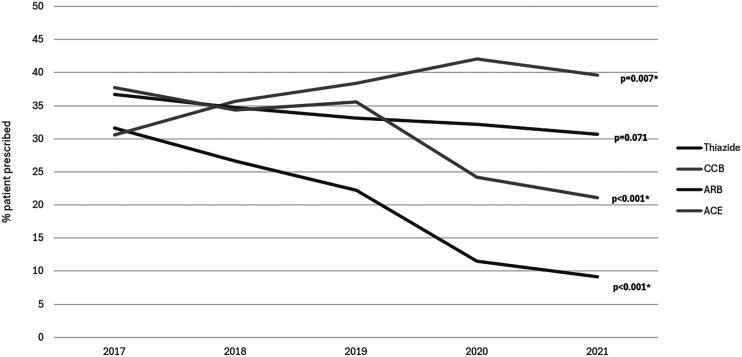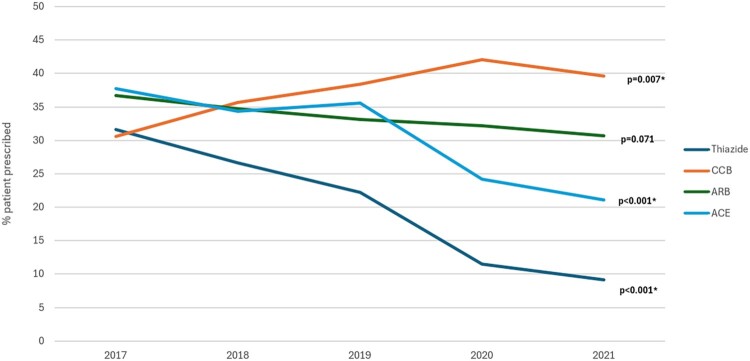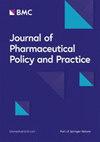Prescribing trends and patterns for antihypertensive agents in primary healthcare settings in Qatar: a retrospective observational study.
IF 2.5
Q1 HEALTH POLICY & SERVICES
Nada Nabil Abdelkader, Ahmed Awaisu, Hazem Elewa, Ziyad Mahfoud, Samya Ahmad Al Abdulla, Amjad Owais, Maguy Saffouh El Hajj
下载PDF
{"title":"Prescribing trends and patterns for antihypertensive agents in primary healthcare settings in Qatar: a retrospective observational study.","authors":"Nada Nabil Abdelkader, Ahmed Awaisu, Hazem Elewa, Ziyad Mahfoud, Samya Ahmad Al Abdulla, Amjad Owais, Maguy Saffouh El Hajj","doi":"10.1080/20523211.2025.2512183","DOIUrl":null,"url":null,"abstract":"<p><strong>Background: </strong>An observational retrospective study was conducted in the primary care setting in Qatar to evaluate the prescribing trends and patterns of antihypertensives in hypertensive patients.</p><p><strong>Methods: </strong>Included patients were adult patients (aged ≥18 years) diagnosed with essential hypertension and attending Primary Health Care Corporation (PHCC) clinics in Qatar between January 2017 and March 2021. A sample of 2185 patients was randomly selected. The data were collected from PHCC's electronic medical records system, Cerner©.</p><p><strong>Results: </strong>Angiotensin Converting Enzyme inhibitors (ACEIs) prescriptions decreased from 38% in 2017 to 21% in 2021, and that of Angiotensin Receptor Blockers (ARBs) from 37% in 2017 to 31% in 2021. Patients with prescribed Calcium Channel Blockers (CCBs) increased from 31% in 2017 to 40% in 2021. The prescribing of thiazide diuretics declined from 32% in 2017 to 9% in 2021. In 2017, the most prescribed antihypertensive class was ACEIs (38%), while the least prescribed antihypertensive class was loop diuretics (1.4%). In 2018, the most prescribed class of antihypertensives was CCBs (36%) and the least prescribed was vasodilators (0.1%). In 2019, 2020 and 2021, CCBs were the most prescribed.</p><p><strong>Conclusion: </strong>These findings are consistent with national and international guidelines for hypertension management and with published literature. Yet, there is still room for improvement to optimise antihypertensive prescribing practices. Prescribers need to address potential gaps and explore ways to enhance their hypertension management, so that patients have access to effective and evidence-based treatments.</p>","PeriodicalId":16740,"journal":{"name":"Journal of Pharmaceutical Policy and Practice","volume":"18 1","pages":"2512183"},"PeriodicalIF":2.5000,"publicationDate":"2025-06-18","publicationTypes":"Journal Article","fieldsOfStudy":null,"isOpenAccess":false,"openAccessPdf":"https://www.ncbi.nlm.nih.gov/pmc/articles/PMC12180352/pdf/","citationCount":"0","resultStr":null,"platform":"Semanticscholar","paperid":null,"PeriodicalName":"Journal of Pharmaceutical Policy and Practice","FirstCategoryId":"1085","ListUrlMain":"https://doi.org/10.1080/20523211.2025.2512183","RegionNum":0,"RegionCategory":null,"ArticlePicture":[],"TitleCN":null,"AbstractTextCN":null,"PMCID":null,"EPubDate":"2025/1/1 0:00:00","PubModel":"eCollection","JCR":"Q1","JCRName":"HEALTH POLICY & SERVICES","Score":null,"Total":0}
引用次数: 0
引用
批量引用
Abstract
Background: An observational retrospective study was conducted in the primary care setting in Qatar to evaluate the prescribing trends and patterns of antihypertensives in hypertensive patients.
Methods: Included patients were adult patients (aged ≥18 years) diagnosed with essential hypertension and attending Primary Health Care Corporation (PHCC) clinics in Qatar between January 2017 and March 2021. A sample of 2185 patients was randomly selected. The data were collected from PHCC's electronic medical records system, Cerner©.
Results: Angiotensin Converting Enzyme inhibitors (ACEIs) prescriptions decreased from 38% in 2017 to 21% in 2021, and that of Angiotensin Receptor Blockers (ARBs) from 37% in 2017 to 31% in 2021. Patients with prescribed Calcium Channel Blockers (CCBs) increased from 31% in 2017 to 40% in 2021. The prescribing of thiazide diuretics declined from 32% in 2017 to 9% in 2021. In 2017, the most prescribed antihypertensive class was ACEIs (38%), while the least prescribed antihypertensive class was loop diuretics (1.4%). In 2018, the most prescribed class of antihypertensives was CCBs (36%) and the least prescribed was vasodilators (0.1%). In 2019, 2020 and 2021, CCBs were the most prescribed.
Conclusion: These findings are consistent with national and international guidelines for hypertension management and with published literature. Yet, there is still room for improvement to optimise antihypertensive prescribing practices. Prescribers need to address potential gaps and explore ways to enhance their hypertension management, so that patients have access to effective and evidence-based treatments.
卡塔尔初级卫生保健机构抗高血压药物的处方趋势和模式:一项回顾性观察性研究
背景:在卡塔尔的初级保健机构进行了一项观察性回顾性研究,以评估高血压患者抗高血压药物的处方趋势和模式。方法:纳入的患者是2017年1月至2021年3月期间在卡塔尔初级卫生保健公司(PHCC)诊所就诊的诊断为原发性高血压的成年患者(年龄≥18岁)。随机抽取2185例患者。数据来自PHCC的电子病历系统Cerner©。结果:血管紧张素转换酶抑制剂(ACEIs)的处方率从2017年的38%下降到2021年的21%,血管紧张素受体阻滞剂(ARBs)的处方率从2017年的37%下降到2021年的31%。服用钙通道阻滞剂(CCBs)的患者从2017年的31%增加到2021年的40%。噻嗪类利尿剂的处方率从2017年的32%下降到2021年的9%。2017年,处方最多的降压药是acei(38%),而处方最少的降压药是利尿剂(1.4%)。2018年,处方最多的抗高血压药物是CCBs(36%),处方最少的是血管扩张剂(0.1%)。2019年、2020年和2021年,建行处方最多。结论:这些发现与国家和国际高血压管理指南以及已发表的文献一致。然而,在优化抗高血压处方实践方面仍有改进的余地。开处方者需要解决潜在的差距,探索加强高血压管理的方法,使患者能够获得有效的循证治疗。
本文章由计算机程序翻译,如有差异,请以英文原文为准。



 求助内容:
求助内容: 应助结果提醒方式:
应助结果提醒方式:


